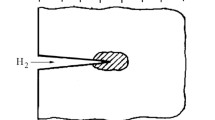Abstract
Most of structural components resisting to high cycle fatigue are subjected to a multiaxial state of stress. Since fatigue cracks generally initiate and propagate in a plane of maximal shear stress (stage I), the first approaches of Crossland and Sines considered the octahedral plane and their criteria are based on the amplitude of the second invariant of the deviatoric stress tensor. In order to take into account the mean stress, these authors postulated also a linear combination of J 2 and the hydrostatic part of the stress tensor. It is now widely recognized that under high cycle loadings conditions, metals fracture is the result of the strain localization in some unfavorably oriented grains undergoing plasticity. Dang Van, followed by Papadopoulos and others, had proposed a multiscale framework which leads to a sufficient condition for non nucleation of cracks under high cycle loading. This condition is ensured by elastic shakedown at the grain scale (see the representive elementary volume on Fig. 1). Nevertheless, microplastic activity alone cannot explain the role of pressure on the fatigue limit and a generalized multiaxial fatigue limit depending on the hydrostatic pressure is due. So far, this is the proposal already suggested by Papadopoulos in his generalized multiaxial fatigue limit.
Access this chapter
Tax calculation will be finalised at checkout
Purchases are for personal use only
Similar content being viewed by others
References
J. G. Antonopoulos, L. M. Brown, A. T. Winter. Vacancy dipoles in fatigued copper. Philosophical Magazine, Vol. 34, No. 4, pp. 549–563, 1976.
M. Berveiller, A. Zaoui. An extension of the self-consistent scheme to plastically flowing polycrystals. J. Mech. Phys. Solids, Vol. 26, pp. 325–344, 1979.
U. Essmann, U. Gosele, H. Mugrhabi. A model of extrusions and intrusions in fatigued metals. I. Point-defects production and the growth of extrusions. Philosophical Magazine A, Vol.44, No. 2, pp. 405–426, 1991.
Author information
Authors and Affiliations
Editor information
Editors and Affiliations
Rights and permissions
Copyright information
© 2006 Springer
About this paper
Cite this paper
Monchiet, V., Charkaluk, E., Kondo, D. (2006). A Micromechanical Model for Crack Initiation in High Cycle Fatigue of Metallic Materials. In: Gdoutos, E.E. (eds) Fracture of Nano and Engineering Materials and Structures. Springer, Dordrecht. https://doi.org/10.1007/1-4020-4972-2_88
Download citation
DOI: https://doi.org/10.1007/1-4020-4972-2_88
Publisher Name: Springer, Dordrecht
Print ISBN: 978-1-4020-4971-2
Online ISBN: 978-1-4020-4972-9
eBook Packages: EngineeringEngineering (R0)




